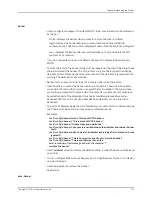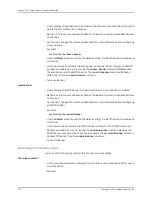
•
Use to display the contents of a macro, script, or text file that resides in NVS on the
primary SRP module, in NVS on the redundant SRP module, or on a remote server that
you access using FTP.
•
Specify the file you want to display using one of the following formats, depending on
the location of the file:
•
fileName
—Name of the file that resides in NVS on the primary SRP module
•
standby:
fileName
—Name of the file that resides in NVS on the redundant (standby)
SRP module
•
serverName
:
filePathName
—Name of the remote server on which the file resides and
the complete pathname of the file
•
Example 1—Displays the contents of a text file named erxconfig.txt that resides in NVS
on the primary SRP module
host1#
more erxconfig.txt
•
Example 2—Displays the contents of a macro file named mysetup.mac that resides in
NVS on the redundant (standby) SRP module
host1#
more standby:mysetup.mac
•
Example 3—Displays the contents of a script file named myconfig.scr that resides on
a remote server named fileserver1
host1#
more fileserver1:/startup/scripts/myconfig.scr
•
There is no
no
version.
•
See more.
Transferring Files
You may need to transfer files between the following locations:
•
System space
•
User space
•
Network host
•
Standby SRP module
You can transfer files in any of three ways: the
copy
command, the system’s FTP server,
or a remote host that is configured as an FTP or a TFTP server. Table 37 on page 290 lists
the types of files that you can transfer between the locations using the
copy
command,
which activates a hidden FTP or TFTP client on the E Series router.
You can use the system’s FTP server to transfer files between a network host and the
user space. When a firewall separates the E Series router from the network host, you
must use the FTP server to transfer files to the user space. You can then install the files
from the user space to the system space by using the
copy
command. However, if there
is no firewall between the E Series router and the network host, you can use the
copy
command, the remote FTP server, or the remote TFTP server to transfer files.
287
Copyright © 2010, Juniper Networks, Inc.
Chapter 5: Managing the System
Summary of Contents for JUNOSE 11.3
Page 6: ...Copyright 2010 Juniper Networks Inc vi...
Page 8: ...Copyright 2010 Juniper Networks Inc viii JunosE 11 3 x System Basics Configuration Guide...
Page 24: ...Copyright 2010 Juniper Networks Inc xxiv JunosE 11 3 x System Basics Configuration Guide...
Page 32: ...Copyright 2010 Juniper Networks Inc 2 JunosE 11 3 x System Basics Configuration Guide...
Page 146: ...Copyright 2010 Juniper Networks Inc 116 JunosE 11 3 x System Basics Configuration Guide...
Page 166: ...Copyright 2010 Juniper Networks Inc 136 JunosE 11 3 x System Basics Configuration Guide...
Page 432: ...Copyright 2010 Juniper Networks Inc 402 JunosE 11 3 x System Basics Configuration Guide...
Page 488: ...Copyright 2010 Juniper Networks Inc 458 JunosE 11 3 x System Basics Configuration Guide...
Page 524: ...Copyright 2010 Juniper Networks Inc 494 JunosE 11 3 x System Basics Configuration Guide...
Page 554: ...Copyright 2010 Juniper Networks Inc 524 JunosE 11 3 x System Basics Configuration Guide...
Page 566: ...Copyright 2010 Juniper Networks Inc 536 JunosE 11 3 x System Basics Configuration Guide...
Page 588: ...Copyright 2010 Juniper Networks Inc 558 JunosE 11 3 x System Basics Configuration Guide...
Page 613: ...PART 3 Index Index on page 585 583 Copyright 2010 Juniper Networks Inc...
Page 614: ...Copyright 2010 Juniper Networks Inc 584 JunosE 11 3 x System Basics Configuration Guide...
Page 632: ...Copyright 2010 Juniper Networks Inc 602 JunosE 11 3 x System Basics Configuration Guide...
















































